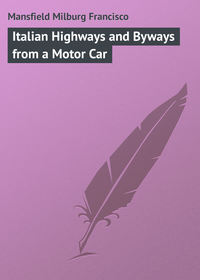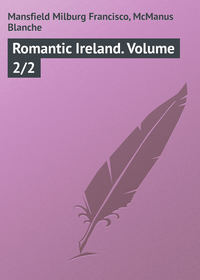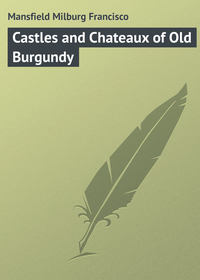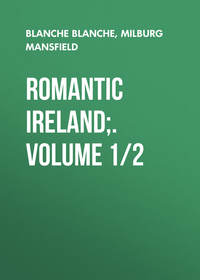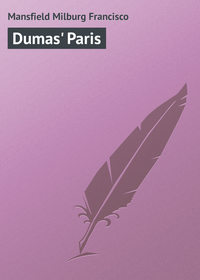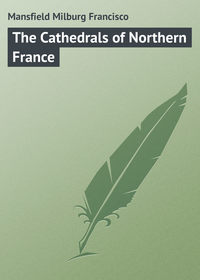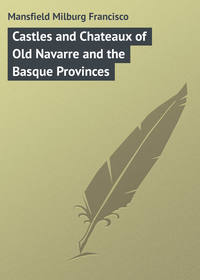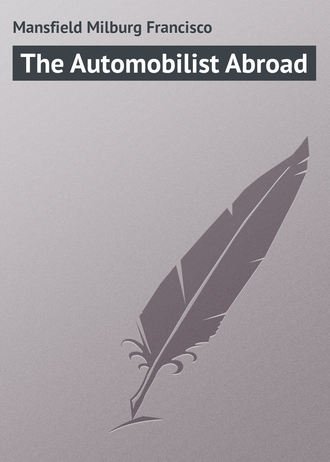 полная версия
полная версияThe Automobilist Abroad
The wines called "wines of the Ahr" resemble those of the Moselle, except that they will keep longer.
The "wines of the Neckar" are made from the best French, Hungarian, and even Cyprus vines. The most celebrated are those of Bessingheim. They are of a light red colour, not deep, and of tolerable flavour and bouquet.
Wiesbaden grows some good wines at Schierstein, and Epstein, near Frankfort. The best wines of Baden are produced in the seigniory of Badenweiler, near Fribourg. At Heidelberg, the great tun used to be filled with the wine of that neighbourhood, boasted to be a hundred and twenty years old, but it gave the wine no advantage over other Neckar growths. Some good wines are produced near Baden. The red wines of Wangen are much esteemed in the country of Bavaria, but they are very ordinary. Würzburg grows the Stein and Liesten wines. The first is produced upon a mountain so called, and is called "wine of the Holy Spirit" by the Hospital of Würzburg, to which it belongs. The Liesten wines are produced upon Mount St. Nicholas. Straw wines are made in Franconia. A vin de liqueur, called Calmus, like the sweet wines of Hungary, is made in the territory of Frankfort, at Aschaffenburg. The best vineyards are those of Bischofsheim. Some wines are made in Saxony, but they are of little worth. Meissen, near Dresden, and Guben, produce the best. Naumberg makes some small wines, like the inferior Burgundies.
With these pages as a general guide the touring automobilist must make his own itinerary. He will not always want to put up for the night in a large town, and will often prefer the quietness and the romantic picturesqueness of some little half-mountain-hidden townlet and its simple fare to a table d'hôte meal, such as he gets at Cologne or Coblenz, which is simply a poor imitation of its Parisian namesake.
The following skeleton gives the leading points.
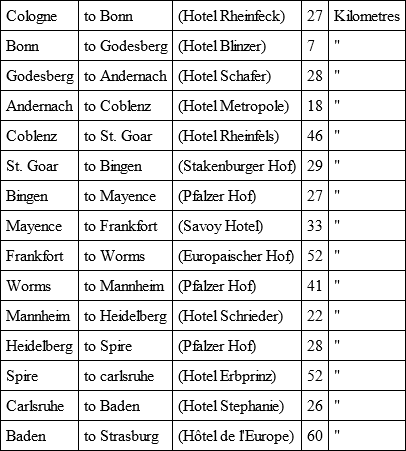
Generally speaking, none of the hotels above mentioned include wine with meals. The trail of the tourist accounts for this. All have accommodation for the automobilist.
From Strasburg one may continue to Bagel, if he is bound Italyward through Switzerland, but the chief distinctive features of the Rhine tour end at Strasburg.
From Strasburg one may enter France by St. Dié, in the Vosges, via the Col de Saales, the douane (custom-house) station for which is at Nouveau Saales.
The following are some of the signs and abbreviations met with in German hotels catering for stranger automobilists.
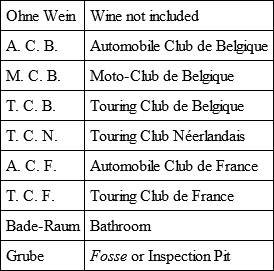
Appendices
Appendix IAppendix IIA SHORT ACCOUNT OF SOME FAMOUS EUROPEAN ROAD RACES AND TRIALS
In December, 1893, Le Petit Journal of Paris proposed a trial of self-propelled road-vehicles, to end with a run from Paris to Rouen. The distance was 133 kilometres and the first car to arrive at Rouen was a steam-tractor built by De Dion, Bouton et Cie, to-day perhaps the largest manufacturers of the ordinary gasoline-motor. A Peugot carriage, fitted with a Daimler engine, followed next, and then a Panhard. There were something like a hundred entries for this trial, of which one was from England and three from Germany, but most of them did not survive the run.
On the 11th of June, 1895, was started the now historic Paris-Bordeaux race. Sixteen gasoline and half a dozen steam cars started from the Arc de Triomphe, in Paris, for the journey to Bordeaux and back. It was a Panhard-Levassor that arrived back in Paris first, but the prize was given to a Peugot which carried four passengers, whereas the Panhard carried but two.
In the following year the new locomotion was evidently believed to have come to stay, for the first journal devoted to the industry and sport was founded in Paris, under the name of La Locomotion Automobile, soon to be followed by another called La France Automobile.
In 1896 was held the Paris-Marseilles race, divided into five stages for the outward journey, and five stages for the homeward. Twenty-four gasoline-cars started, and three propelled by steam, and there were five gasoline-tricycles. Bolée's tandem tricycle was the sensation during the first stage, averaging twenty miles an hour. The itinerary out and back, of something like sixteen hundred kilometres, was covered first by a Panhard-Levassor, in sixty-seven hours, forty-two minutes, and fifty-eight seconds. The average speed of the winner was something like twenty-two kilometres an hour.
In England a motor-car run was organized from London to Brighton in 1896, including many of the vehicles which had started in the Paris-Marseilles race in France. The first vehicles to arrive in Brighton were the two Bolée tricycles; a Duryea was third, and a Panhard fourth.
In 1897 there was a race in France, on a course laid out between Marseilles, Nice, and La Turbie. The struggle was principally between the Comte Chasseloup-Laubat in a steam-car, and M. Lemaitre in a Panhard, with a victory for the former, showing at least that there were possibilities in the steam-car which gasoline had not entirely surpassed.
Pneumatic tires were used on the Paris-Bordeaux race in 1895, but solid tires were used on the winning cars in 1894, 1895, and 1896.
Another affair which came off in 1897 was a race from Paris to Dieppe, organized by two Paris newspapers, the Figaro and Les Sports.
The event was won by a three-wheeled Bolée, with a De Dion second, and a six-horse-power Panhard third.
In 1898 there took place the Paris-Amsterdam race. It was won by a Panhard, driven by Charron, and the distance was approximately a thousand miles, something like sixteen hundred kilometres.
The "Tour de France" was organized by the Matin in 1898. The distance was practically two thousand kilometres. Panhards won the first, second, third, and fourth places, though they were severely pressed by Mors.
The first Gordon-Bennett cup race was held in 1900, between Paris and Lyons. The distance was not great, but the trial was in a measure under general road conditions, though it took on all the aspects of a race. It was won by Charron in a Panhard.
In 1901 the Gordon-Bennett race was run from Paris to Bordeaux, perhaps the most ideal course in all the world for such an event. It was won by Girardot in a forty-horse Panhard.
The Paris-Berlin race came in the same year, with Fournier as winner, in a Mors designed by Brazier.
In 1902 the Gordon-Bennett formed a part of the Paris-Vienna itinerary, the finish being at Innsbruck in the Tyrol. De Knyff in a Panhard had victory well within his grasp when, by a misfortune in the parting of his transmission gear, he was beaten by Edge in the English Napier. Luck had something to do with it, of course, but Edge was a capable and experienced driver and made the most of each and every opportunity.
Through to Vienna the race was won by Farman in a seventy-horse-power Panhard, though Marcel Renault in a Renault "Voiture Legere" was first to arrive.
It was in 1901 that the famous Mercédès first met with road victories. A thirty-five-horse power Mercédès won the Nice-Salon-Nice event in the south of France, and again in the following year the Nice-La Turbie event.
In the Circuit des Ardennes event in 1902, Jarrot, in a seventy-horse Panhard, and Gabriel in a Mors, were practically tied until the last round, when Jarrot finally won, having made the entire distance (approximately 450 kilometres) at an average speed of fifty-four and a half miles per hour. There were no controles.
In 1903 the Gordon-Bennett cup race was held in Ireland, over a course of 368 miles, twice around a figure-eight track. Germany won with a Mercédès with Jenatzy at the wheel, with De Knyff in a Panhard only ten minutes behind.
In 1903 was undertaken the disastrous Paris-Madrid road race. Between Versailles and Bordeaux the accidents were so numerous and terrible, due principally to reckless driving, that the affair was abandoned at Bordeaux. Gabriel in a Mors car made the astonishing average of sixty-two and a half miles per hour, hence may be considered the winner as far as Bordeaux.
In 1904 the Gordon-Bennett race was run over the Taunus course in Germany, with Thèry the winner in a Richard-Brazier car.
In 1905 Thèry again won on the Circuit d'Auvergne in the same make of car, making a sensational victory which – to the French at least – has apparently assured the automobile supremacy to France for all time.
The 1906 event was the Grand Prix of the Automobile Club de France on the Circuit de la Sarthe. The astonishing victories of the Renault car driven by Szisz, which made the round of 680 kilometres in two days at the average rate of speed of 108 kilometres an hour, has elated all connected with the French automobile industry. It was a victory for removable rims also, as had Szisz not been able to replace his tattered tires almost instanteously with others already blown up, he would certainly have been overtaken by one or more of the Brazier cars, which suffered greatly from tire troubles.
In 1906 another event was organized in France by the Matin. It was hardly in the nature of a race, but a trial of over six thousand kilometres, an extended tour de France.
Forty-two automobiles of all ranks left the Place de la Concorde at Paris on the 2d of August, and thirty-three arrived at Paris on the 28th of the same month, twenty of them without penalization of any sort. No such reliability trial was ever held previously, and it showed that the worth of the comparatively tiny eight and ten horse machines for the work was quite as great as that of the forty and sixty horse monsters.
The following tables show plainly the value of this great trial.
COUPE DU MATIN
LIST OF AUTOMOBILES ENGAGED
CLASS "ROUES" (SPRING WHEELS AND ANTI-SKIDS)
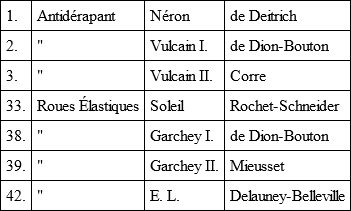
CLASS ENDURANCE
1st Category
Motocyclettes, vitesse maxima, 25 kilomètres à l'heure

2d Category
Tri-cars, vitesse maxima, 25 kilomètres à l'heure

3d Category
Voiturette 1 cylindre, alésage maximum 110 millimètres
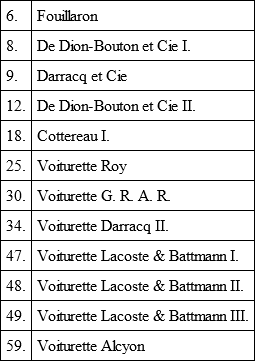
4th Category
Voitures 2 cylindres, alésage maximum 130 millimètres, ou 4 cylindres, alésage maximum 85 millimètres
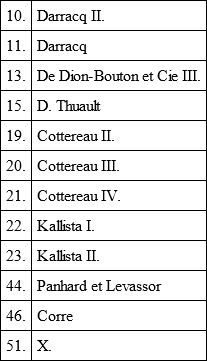
5th Category
Voitures 4 cylindres, alésage maximum 105 millimètres
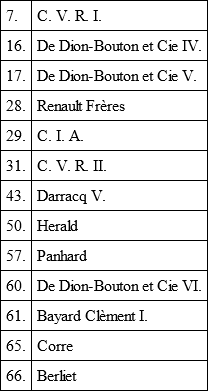
6th Category
Voitures 4 cylindres, alésage maximum 126 millimètres
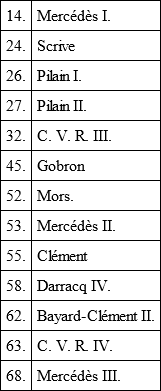
7th Category
Voitures 4 cylindres, alésage maximum 140 millimètres

SOME FAMOUS HILL CLIMBS ABROAD
ENGLAND
Birdlip Hill. – Near Gloucester. Length, 2 miles; average gradient, 1 in 8; steepest gradient, 1 in 7
Dashwood Hill. – Near High Wycombe. Length, 1,180 yards; average gradient, 1 in 16; steepest gradient, 1 in 10.9.
Hindhead. – Near Guildford. Length, 2 3/4 miles, rise, 520 feet; average gradient, 1 in 24.4; steepest gradient, 1 in 13.
Porlock Hill. – North Devon. Length, 3 miles; rise, 1,365 feet; gradient, 1 in 6 to 1 in 8.
Shap Fell. – Near Penrith. Rise, 1,886 feet, gradients, 1 in 11, 1 in 15, 1 in 16, and 1 in 20.
Snowdon. – Mountain in Wales. Steepest gradient, 1 in 7.
Westerham. – Length, 2,940 feet; average gradient, 1 in 9.4.
FRANCE
Château Thierry. – Near Meaux. Length, 1,098 yards.
Côte de Gaillon. – Near Rouen. The scene of the most famous hill climbs in France. Length, 3 kilometres, rise, 10 per cent. for the greater part of the distance.
Côte de Laffray. – Near Grenoble. Length, 4.13 miles; gradients, 1 in 15, 1 in 11, 1 in 10, and 1 in 8; average, 9.3 per cent; many bad turns.
La Turbie. – A rude foot-hill climb in the Maritime Alps just back of Monte Carlo.
Mont Ventoux. – Near Avignon. Length, 20 kilometres; rise 1,600 metres.
Mont Cenis. – Near Turin. The "climb" begins at Susa, on the Italian side of the mountain, at the 596 metre level, and continues for 22 kilometres to the 2,087 metre level, a 100 h.p. Fiat climbed this in 1905 in 19 minutes, 18 3/5 seconds.
Appendix VIITHE AUTOMOBILE INDUSTRY IN FRANCE

HOURS OF MOONLIGHT

THE LENGTH OF DAYS
After the method of M. Carlier, Ingénieur des Arts et Manufactures.
Figured for the latitude of Paris, but applicable so far as the automobilist is concerned to most of continental Europe.
The deeply shaded portions represent night.
The lightly shaded portions twilight.
The white portions daylight.
Generally speaking, lamps must be lighted at the hour indicated by deeply shaded portions in the respective months.
Appendix XTHE TOURING CLUB DE FRANCE
The Touring Club de France is the largest and most active national association for the promotion of touring. It is under the direct patronage of the President of the French Republic, and the interests and wants of its members are protected and provided for in a full and practical manner by an excellent organization, whose influence is felt in every part of France and the adjacent countries.
The membership is over 100,000 and is steadily growing. It includes a very considerable body of foreign members, those from the United Kingdom and America alone numbering 5,000, a circumstance which may be accepted, perhaps, as the best possible proofs of the value of the advantages which the club offers to tourists from abroad visiting France.
The annual subscription is 6 francs (5s.) for foreign members. There is no entrance fee and the election of candidates generally follows within a few days after the receipt of the application at the offices of the club in Paris.
The club issues a number of publications specially compiled for cyclists, comprising: a Yearbook (Annuaire) for France divided in two parts (North and South) with a list of over three thousand selected club hotels, at which members enjoy a privileged position as to charges; an admirable volume of skeleton tours covering the whole of France, from each large centre, and by regions, and supplemented by some three hundred card itineraries with sketch maps; a specially drawn cyclist's map of France, and a monthly club gazette, all designed to facilitate the planning and carrying out of interesting tours with comfort and economy.
INSTRUCTIONS TO CANDIDATES
Fill in the application form and enclose it with the subscription (6 francs) to M. le Président du T. C. F., 65, Avenue de la Grande-Armée, Paris. The applications of lady candidates should be signed by a male relative– brother, father, husband – whether a member of the club or not.
Notice of resignation of membership must reach the Paris office of the club not later than November 30th, failing which the member is liable for the following year's subscription. Those who join after October 1st are entitled to the privileges of membership until the close of the following year for one subscription.
Post-office money orders should be made payable to M. le Trésorier du T. C. F., 65, Avenue de la Grande-Armée, Paris, France.
The addresses of the representatives of the Touring Club de France in England and America are as follows; further information concerning this admirable institution for all travellers whether by train, bicycle, or automobile will be gladly furnished. They can also supply forms for application for membership.
DELEGATES
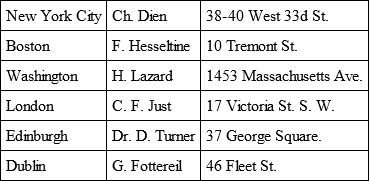
MOTOR-CAR REGULATIONS AND CUSTOMS DUTIES IN EUROPE
GREAT BRITAIN
Certain regulations are compulsory even for tourists. You may obtain a license to drive a motor-car in Britain if you are over seventeen years of age (renewable every twelve months) at a cost of five shillings.
You must register your motor-car at the County or Borough Council offices where you reside, fee £1.0.0. You must pay a yearly "male servant" tax of fifteen shillings for your chauffeur. In case of accident, en route, you must stop and, if required, give your name and address, also name and address of the owner of the car and the car number.
Every car must bear two number plates (the number is assigned you on registration), one front and one rear. The latter must be lighted at night.
Speed limit is twenty miles an hour except where notice is posted to the effect that ten miles an hour only is allowed, or that some particular road is forbidden to automobiles.
In England one's car can be registered at any port on arrival, or, by letter addressed to any licensing authority, before arrival. The regulation as to driving licenses is as follows:
"If any person applies to the Council of a county or county borough for the grant of a license and the Council are satisfied that he has no residence in the United Kingdom, the Council shall, if the applicant is otherwise entitled, grant him a license, notwithstanding that he is not resident within their county or county borough."
As regards the Inland Revenue Carriage License, however, it may be noted that twenty-one days' grace is allowed – in other words, that licenses must be obtained within twenty-one days after first becoming liable to the duty.
There are no customs duties on automobiles entering Great Britain.
FRANCE
CERTIFICAT DE CAPACITÉ AND RÉCÉPISSÉ DE DÉCLARATION
Before taking an automobile upon the road in France all drivers must procure the Certificat de Capacité, commonly known as the "Carte Rouge."
The following letter should be addressed to the nearest préfecture, or sous-préfecture, written on stamped paper (papier timbré, 60 centimes) and accompanied by two miniature photographs.
"Monsieur: – J'ai l'honneur de vous demander de me faire convoquer pour subir l'examen nécessaire à l'obtention d'un certificat de capacité pour la conduite d'une voiture… (indiquer la marque) mue par un moteur à petrole.
"Veuillez agréer, etc."
At the same time another letter should be addressed to the same authority requesting a Récépissé de Déclaration. These applications must be quite separate and distinct; each on its own papier timbre, which you buy at any bureau de tabac.
"Monsieur Le Préfet: – Je soussigné … (nom, prénom, domicile) propriétaire d'une voiture automobile actionnée par un moteur à pétrole système (type et numéro du type), ai l'honneur de vous demander un permis de circulation.
"Vous trouverez sons ce pli le procès-verbal de réception délivré par le constructeur.
"Veuillez agréer, etc."
NAMES OF ARRONDISSEMENTS AND DISTINGUISHING LETTERS BORNE BY AUTOMOBILES IN FRANCE
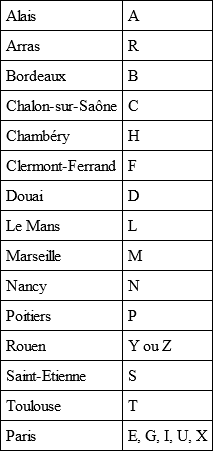
CUSTOMS DUTIES IN FRANCE.
Fifty francs per 100 kilos on all motor vehicles weighing more than 125 kilos. Automobiles (including motor-cycles) weighing less than 125 kilos pay a flat rate of 120 francs.
Members of most cycling touring clubs can arrange for the entry of motor-cycles free of duty.
All customs duties paid, in France may be reimbursed upon the exportation of the automobile. The formalities are very simple. Inquire at burèau of entry.
BELGIUM
Customs Dues. 12 1/2 per cent. ad valorem (owners' declaration as to value), but the authorities reserve the right to purchase at owners valuation if they think it undervalued. This is supposed to prevent fraud, and no doubt it does.
A driving certificate is not required of tourists, but a registered number must be carried. Plates and a permit are supplied at the frontier station by which one enters, or they may be obtained at Brussels from the chef de police.
Speed limit: 30 kilometres per hour in the open country and 10 kilometres per hour in the towns, except, generally speaking, the larger cities hold down the speed to that of a trotting horse.
HOLLAND
Customs Dues are five per cent, ad valorem, but in practice nothing is demanded of genuine tourists and a permit is now given (1906) for eight days with a right of extension for a similar period.
Foreign number plates, once recorded by the Dutch customs officials, will supplant the need of local number plates.
SWITZERLAND
Customs Dues are 60 francs per 100 kilos. This amount, deposited on entering the country, will be refunded upon leaving and complying with the formalities.
Legally a driving and "circulation" permit may be demanded, but often this is waived.
In the Canton Valais only the main road from St. Maurice to Brigue is open for automobile traffic. Many other roads are entirely closed.
N.B. Traffic regulations in many parts are exceedingly onerous and often unfair to foreigners.
A recent conference of the different cantons has been held at Berne to consider the question of automobile traffic in the country. It was decided to fix a blue sign on the roads where motorists must slacken speed, and a yellow sign where motoring is not allowed. The Department of the Interior was deputed to draw up a uniform code of rules for the guidance of police deputed to take charge of the roads. No decision was arrived at as regards uniformity in fines for infraction of the regulations, but steps are to be taken to put an end to the abuses to which it is alleged the police have subjected motorists. A resolution was furthermore adopted to the effect that no road is to be closed to motor-cars without an agreement between the authorities of all the cantons concerned, and that all foreign motorists shall be given a copy of the regulations on entering the country.
The above information is given here that no one may be unduly frightened, but there is no question but that Switzerland has not been so hospitable to automobile tourists as to other classes.
The Simplon Pass, under certain restrictions has recently been opened to automobiles. Open from June 1st to October 15th, except on Mondays, Thursdays, and Saturdays, but no departure can be made from either Brigue or Gondo after three P. M. Apply for pass at the Gendarmerie. Speed 10 kilometres on the open road, and 3 kilometres on curves and in tunnels.
ITALY
Customs Dues are according to weight.
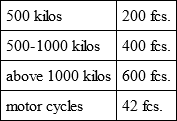
A certificate for importation temporaire is given by the customs officers on entering, and the same must be given up on leaving the country, when the sum deposited will be reimbursed.
Since January 8, 1905, a driving certificate is compulsory, but the authorities will issue same readily to tourists against foreign certificates or licenses.




